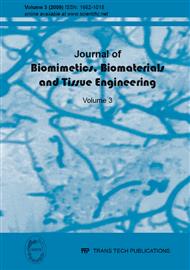p.1
p.25
p.37
p.51
p.59
p.93
Tomography Observations of Osteoblast Seeding on 3-D Collagen Scaffold by Synchrotron Radiation Hard X-Ray
Abstract:
In recent years, research into three-dimensional (3-D) scaffolds for tissue engineering has become an important topic. To avoid biological rejection, there are many biocompatible materials being developed for in vitro cultivation of autologous cells for implantation into the human body. The 3-D structures of scaffolds are not easily observed using traditional optical or electron microscopes, which only allow examination of the surfaces of samples or ultra thin films, and often require complicated pre-treating processes. The high-brilliance synchrotron radiation (SR) hard X-ray is an emerging technique to acquire tomography. This study involves the successful reconstruction of 3-D images and the animation of the structure of a collagen scaffold. The images were obtained using synchrotron radiation hard X-ray images, which eliminates the need for embedding and microtoming. SR hard X-ray imaging is a non-destructive technique, which has demonstrated a high spatial resolution and transmission, enabling the morphology of osteoblasts adhered on the inner surfaces of the collagen scaffolds to be captured. It is a convenient facility to obtain 3-D tomography images for biomaterial studies. This is the first study to observe the 3-D structures of collagen scaffolds and aquire detailed images of osteoblast attachment on the scaffold, by utilization of third-generation SR hard X-ray radiography.
Info:
Periodical:
Pages:
93-101
Citation:
Online since:
July 2009
Keywords:
Price:
Сopyright:
© 2009 Trans Tech Publications Ltd. All Rights Reserved
Share:
Citation:


